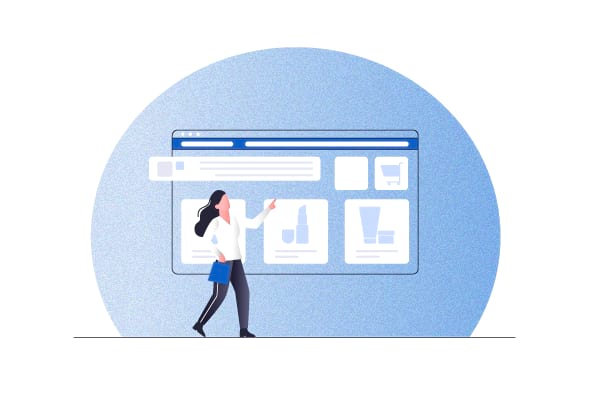eCommerce subscription — or selling (physical) eCommerce products as subscriptions — is a great way to convert one-time or ad hoc customers into lifetime subscribers. In fact, pivoting to the subscription model is one of the best growth hacks for eCommerce stores looking to grow their business and build long-term customer relationships, according to McKinsey. McKinsey also found that the subscription eCommerce market grew by over 100 percent per year over the last five years. And according to eMarketer’s research, subscription eCommerce sales grew by 41.0% during the pandemic alone.
Consumers, too, love subscribing to eCommerce products. Autoshipping their regular supplies — pantry items, pet food, supplements, baby products, home goods, etc. — on a schedule is very convenient for them (since they don’t need to go to a store, stock up their cart, and complete a tedious checkout). Also popular are subscription “boxes” handpicked based on their preferences, whether apparel, cosmetics, or weed. Subscribing to exclusive offers or access to products — be it fashion or wellness — is another excellent reason to subscribe. On average, eCommerce subscribers hold at least two subscriptions, with 35% maintaining three.
Thanks to customers’ increasing preferences for subscriptions (65% of U.S. consumers said they’re open to product subscriptions in Attest’s research), the subscription eCommerce economy is booming. The eCommerce subscription model is predicted to grow as awareness grows.
If you haven’t already added subscriptions to your online store, now is an excellent time. Doing so is really easy if you run your store on WooCommerce. All you need in this case is Autoship Cloud, a WooCommerce subscription plugin that turns your regular products into Amazon-like eCommerce subscriptions in just a few clicks with no custom coding! There’s a free trial available — click here to sign up. (More on this below.)
In this article, we’ll see:
- What eCommerce subscription is all about
- The different eCommerce subscription models with examples
- The top eCommerce subscription platforms
- The best scheduled commerce solution (QPilot) and how you can set up subscriptions on your WooCommerce store with QPilot’s Autoship Cloud
- And a few essential eCommerce subscription best practices
Let’s dive in.
What are eCommerce subscriptions? Examples of eCommerce subscriptions
eCommerce subscriptions are physical eCommerce products that customers can subscribe to. Unlike conventional eCommerce, where the focus is on making one-off sales, subscription stores push their customers to subscribe to their products.
For merchants, the subscription business model means:
1. Improved customer retention: In general, eCommerce stores report an average monthly user retention rate of 1%. Subscription stores, on the other hand, depending on the vertical, get up to 41% retention rates even across the 12-month mark.
2. Higher revenue: Every eCommerce business relies on recurring revenue to grow. Subscriptions enable you to build recurring revenue consistently. Subscribers are repeat buyers, so when you sell subscriptions, your average customer lifetime value increases as well. Across all verticals, the average customer lifetime value for eCommerce subscription stores increased by 15%, according to Recharge’s research.
3. Happier customers: Increasingly, consumers are opting for eCommerce subscriptions. In 2021, eCommerce stores steadily grew their subscriber base with an average 43% monthly subscriber growth YOY. You can offer your customers more convenience, personalization, and value by introducing subscriptions.
Let’s now look at the three types of subscriptions in the eCommerce industry.
The top three eCommerce subscription models
Replenishment subscription service
The replenishment eCommerce subscription model (also called the subscribe-and-save model) involves selling consumables or daily necessity products. This model gets the best 12-month retention rate (at 42%) in the home goods niche. This isn’t surprising since home supplies need regular restocking. When it comes to the replenishment model, pet foods, baby products, and supplements are the most popular subscriptions.
Example: Dollar Shave Club, a replenishment subscription for razors/grooming products:

Curation subscription service
The curation eCommerce subscription model means shipping curated “themed” boxes to subscribers based on their preferences. From hobby items and cosmetics to apparel and CBD, curated boxes have their place in the subscription economy. More than half of all eCommerce subscription sales (55%) are for curated boxes. Users love unpacking their curated boxes and finding new stuff to try.
Example: Birchbox, a curated subscription in the beauty niche:

Access subscription service
The access eCommerce subscription model (also called the membership model) is where consumers subscribe to access subscriber-only stuff. These can be anything from exclusive product releases to discounts or offers like free shipping.
Most eCommerce platforms don’t ship with subscription functionalities. So to sell subscriptions on them, you need to turn your regular eCommerce platform into an eCommerce subscription platform with the help of a third-party solution. Here’s a quick overview of the top eCommerce subscription platforms.
Example: JustFab, an access-based subscription apparel service
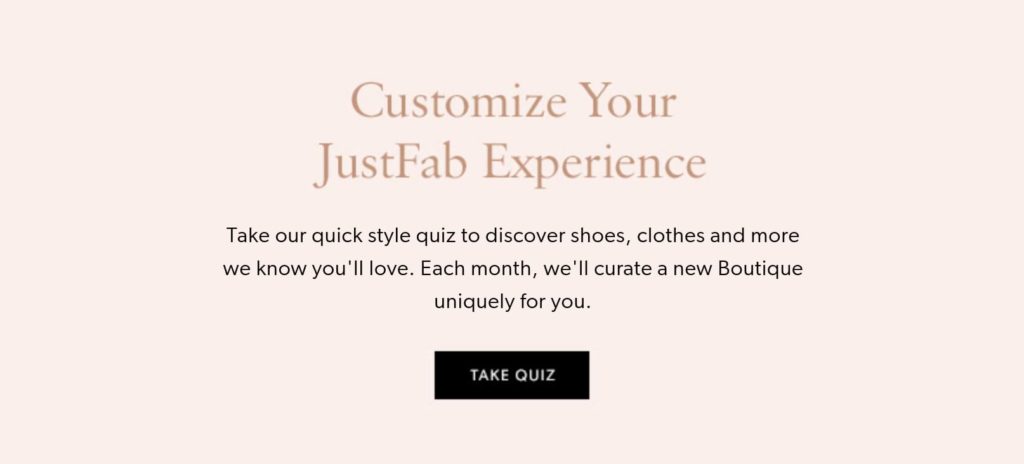
The top eCommerce subscription platforms
In response to the increasing need for subscription-based eCommerce stores, most eCommerce platforms now provide their own subscription eCommerce solutions or integrate with third-party ones that work on top of their existing infrastructure.
1. WooCommerce
WooCommerce doesn’t support subscriptions by default. But you can set up subscriptions on a WooCommerce store with the help of an eCommerce subscription solution like QPilot. QPilot, in fact, comes with Autoship Cloud — a WooCommerce subscription plugin to bring the robust QPilot eCommerce subscription engine natively to WooCommerce. (More about Autoship Cloud in a bit.) You can also consider WooCommerce subscription plugins like WooCommerce Subscriptions and YITH WooCommerce subscription to turn WooCommerce into an eCommerce subscription platform.
2. Shopify
Shopify, just like WooCommerce, doesn’t support subscriptions natively. But just the way you can use a subscription plugin to bring subscriptions to WooCommerce, you can use a subscription app to add subscriptions to your Shopify store. You have Shopify subscription apps like Recharge Subscriptions and Seal Subscriptions to help you launch your eCommerce subscription services.
3. Magento (Adobe Commerce)
It’s also possible to set up subscription eCommerce products on Magento (now Abode Commerce) stores. You can browse through Magento’s marketplace to find apps like Subscriptions & Recurring Payments that let you convert your simple eCommerce products into subscriptions.
Website builders like Squarespace and WordPress.com also support subscriptions.
Before we see how you can set up eCommerce subscriptions on your store, let’s see how eCommerce subscriptions are processed.
How eCommerce subscriptions get processed
While there are many moving parts to the eCommerce subscription model, at any time, you’re looking at three major ops:
1. Enabling subscriptions
At the very core, your subscription solution turns your regular products into subscriptions. This means, your eCommerce platform automatically creates an order for a product (based on a subscriber’s plan), charges a recurring payment (directly or with the authorization of the subscriber), ships, and then renews the order until the subscription runs out.
2. Scheduling of orders and repeat order processing
If a subscriber is on a monthly plan, your subscription solution will place a repeat order for their product a few days before the next cycle. For instance, for a monthly subscription that renews on the 10th, your subscription solution will create a repeat order on the 5th. This gives you time to figure out how to fulfill the order. With QPilot, you can even send subscribers an email when their subscription renewal order is being processed, allowing your subscribers to request skips, swaps, and changes. They can even update their payment method or delivery address. QPilot automatically recalculates shipping rates if items or delivery addresses change.
3. Recurring payment processing
Finally, your subscription solution communicates with your payment gateway to initiate an automatic recurring payment. For a successful subscription renewal payment processing, the subscription’s next delivery date is set (based on the subscription plan). If a subscription renewal payment fails, Autoship Cloud updates the subscription order with the reason (as explained via the payment gateway) and sends you an email to let you know.
Let’s now explore Autoship Cloud, QPilot’s subscription solution for WooCommerce.
Meet Autoship Cloud
Autoship Cloud is a WooCommerce subscriptions plugin that lets you set up your eCommerce products as subscriptions on your store.
With Autoship Cloud, you can add Amazon-like subscribe and save subscription plans to all your product pages. Autoship Cloud works on the cart/checkout page as well, so you can pitch the upgrade subscription during the checkout too.
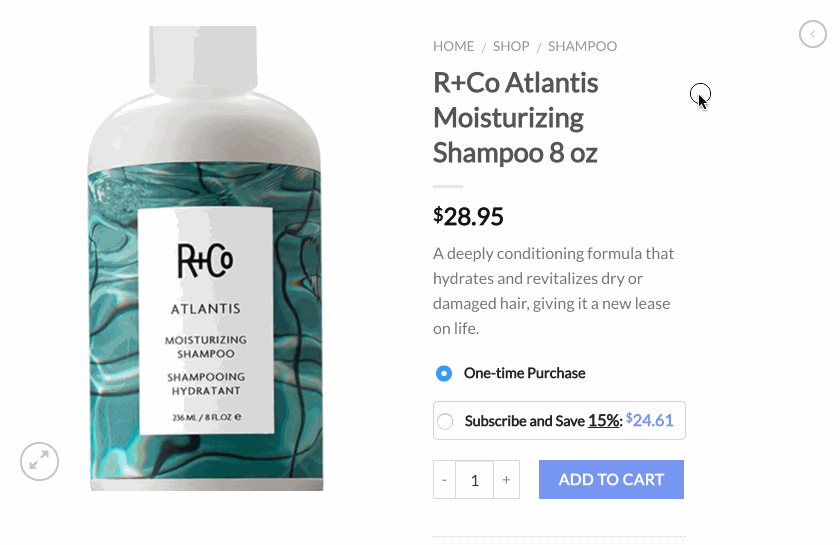

Grow Subscriptions with Autoship Cloud
Mission Farms migrated to Autoship Cloud powered by QPilot so that they could offer a better experience for their existing Subscribers, reduce the overhead of plugins + code needed to manage subscriptions with their online store, and work with a partner that knows how to support growing their subscription revenue. Since their migration in July of 2022, Mission Farms has improved their Active Subscriber count 52% and grown Subscription Revenue over 62%!
Ready to grow your subscription revenue?
Retain the one-time purchase option
Autoship Cloud also doesn’t force you to open a “subscription-only” — where products only sell as subscriptions. Besides being able to choose which products to sell as subscriptions, you also get to offer both one-time and recurring options on your product pages. You need to retain the one-time purchase option even if you want your users to subscribe. Why? Having a one-time purchase option along with other subscription management features like letting users skip scheduled orders or swap plans can lead to a 6% increase in the average order value. You’d be surprised to know that most WooCommerce subscription plugins don’t support this right out of the box.
Let users check out with both subscription and non-subscription products
Autoship Cloud supports mixed checkout, so your users can check out with both subscription and non-subscription products in one go. As noted above, one-time sales are just as important even for eCommerce stores that sell subscriptions.
Improve order value with cool upselling and cross-selling tools
Autoship Cloud comes with a slick one-click upsell feature where you can pitch (one-time purchase) products to your users that they can add to their upcoming scheduled orders with just a click. So if you see pet food as subscriptions, you can pitch a nice bowl once in a while. You get the drift! When users add an item to their upcoming orders, Autoship Cloud communicates with your payment gateway to adjust the chargeable amount.
Check out Autoship Cloud’s one-click one-time purchase upsell/cross-sell feature:
With Autoship Cloud, you can quickly launch schemes like “Choose any three and get an additional 10% off…” (Yes! These are product bundles!)
Here’s a WooCommerce store selling product bundles with Autoship Cloud:
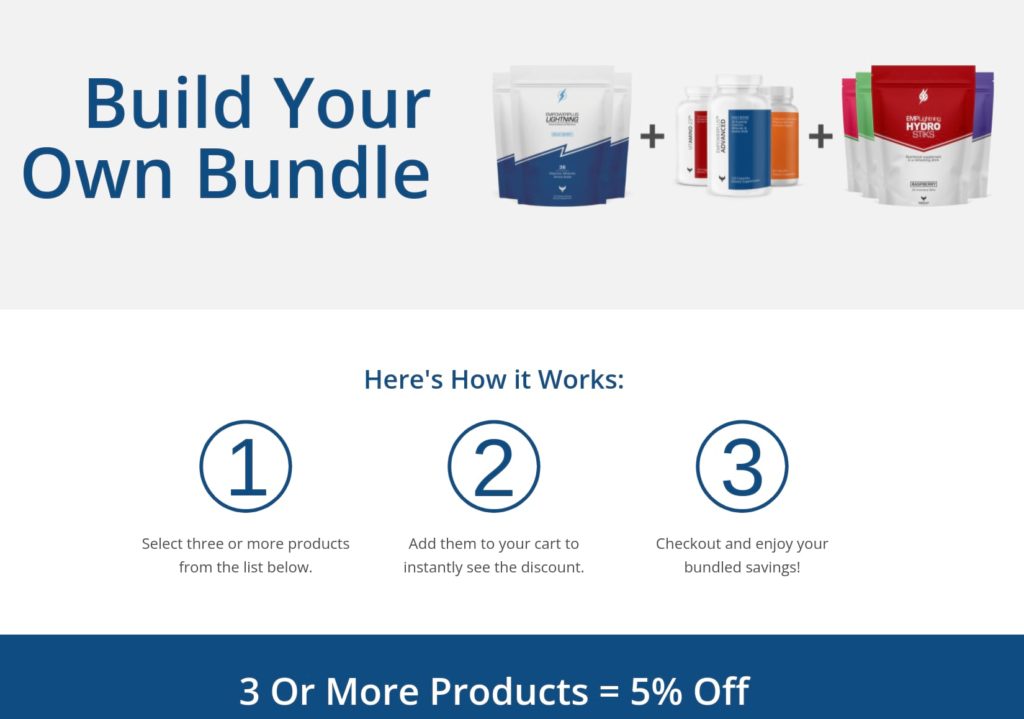
Autoship Cloud comes with many tools to let you sell more. By offering coupons only for higher cart values, you can encourage your users to buy more. Additionally, you may be able to gain more subscribers if you waive the shipping fee. It’s also possible to send free trial samples.
Give users their favorite payment options
Autoship Cloud integrates with over ten payment gateways, including:
From PayPal to debit and credit cards, you can offer plenty of payment methods to your subscribers. Even if you’re in a high-risk industry (CBD, for instance), you can find a suitable payment gateway to power your recurring WooCommerce payments.
Give your users powerful subscription management tools
With Autoship Cloud, your subscribers get complete control over their subscription experience. We’ve found that when customers get flexible subscription options, they don’t default to canceling. Subscribers that make at least two changes to their subscriptions have a 250% higher lifetime value than those that don’t.
Autoship Cloud’s subscription management tools for subscribers:
- Autoship Cloud lets your subscribers easily upgrade, downgrade, switch, pause, cancel, and resume their subscriptions.
- Subscribers can make changes to their upcoming deliveries (such as adding more products, removing some, or changing quantities). However, you can specify a lock period after which no subscription change requests will be accepted. You can even send out an email to your subscribers before you “lock” their upcoming subscription shipment. This gives them the window they need for making changes.
- Your subscribers can even skip an upcoming delivery (similar to pausing) and even request a delivery date different from the subscription cycle. Subscribers can even change their autoshipping schedules and frequencies.
In addition to these, your subscribers can also easily update their shipping and billing information. Autoship Cloud is easily the most subscriber-friendly subscription solution for WooCommerce.
Offer your subscribers the best shipping rates
Autoship Cloud integrates with a host of shipping services and even with ShipperHQ. Each time a subscription shipment is to be delivered, it recalculates the shipping fee according to your rules. Seamless integration with shipping carriers ensures that your users get the best shipping rates each time. You can use Autoship Cloud to offer free shipping to your subscribers — which can be an excellent incentive for subscribing. Additionally, you can provide a flat rate or a percentage discount based on the value of the order.
Keep your subscribers engaged throughout the subscription lifecycle
With Autoship Cloud’s native integration with SendGrid®, you can send your subscribers advance notifications about their upcoming orders, as well as updates on failed orders and payments. You can also email your users before they’re charged their automatic subscription payment — believe it or not, most WooCommerce subscription plugins only let you notify your users post charging them.
Autoship Cloud ships with a slick email editor that comes with pre-built templates:
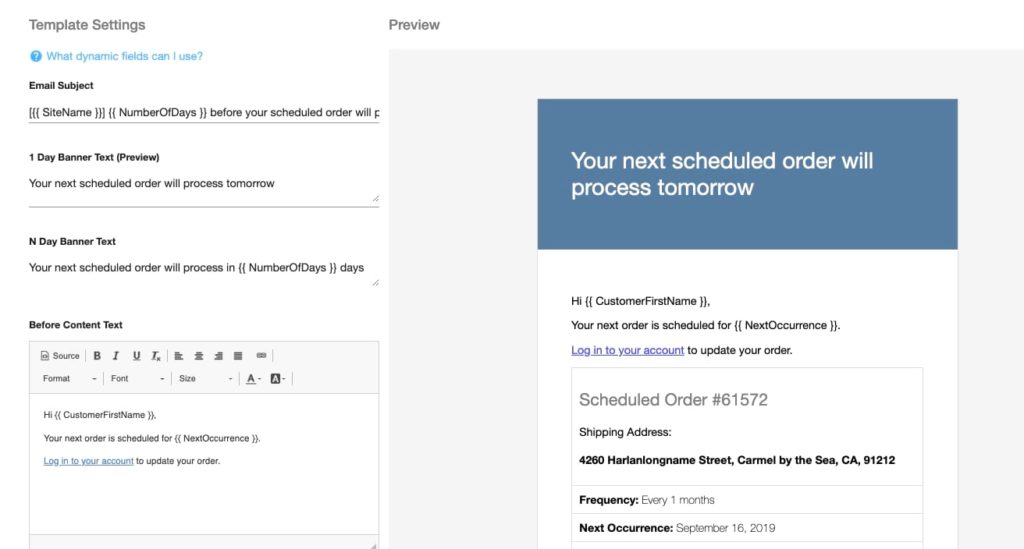
As you can see, you can easily brand Autoship Coud’s email templates and edit their copy to make them your own. Your email communications can be put on automation easily.
In addition to these, Autoship Cloud also gives you some of the best-in-class subscription business reporting, with quick access to metrics/KPIs like the net new subscriber count, average customer lifetime value, among others. These add predictability to your eCommerce sales mix.
You can use Autoship Cloud to set up all kinds of subscriptions — replenishment, curation, and access — on a WooCommerce store. Sign up for Autoship Cloud now. You get a fully-featured two-week trial when you sign up. Here’s how you can use Autoship Cloud to sell subscriptions on your online store.
Setting up subscriptions on WooCommerce with Autoship Cloud.
To get started, you need to:
- Sign up for a QPilot merchant account
- Download QPilot Autoship Cloud plugin
- And connect the two.
Here’s a video tutorial to guide you through the process:
Or you can follow this guide.
Once you’ve connected both, find Autoship Cloud’s global rules under the Utilities tab and follow these steps.
Step #1: Enable product sync for all your products. Check the Activate All Products option and click Update Products to do so:
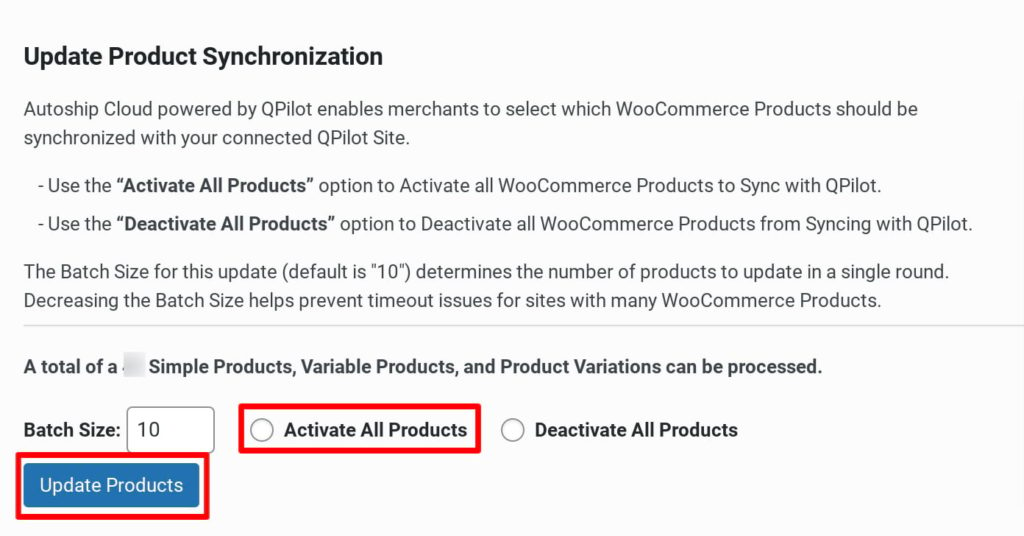
Step #2: Now set a (recurring) discount that you want to offer to your customers as the incentive to subscribe. To do so, jump to the Bulk Update Autoship Recurring Price section, set the Percent Discount value, and click Update Products:
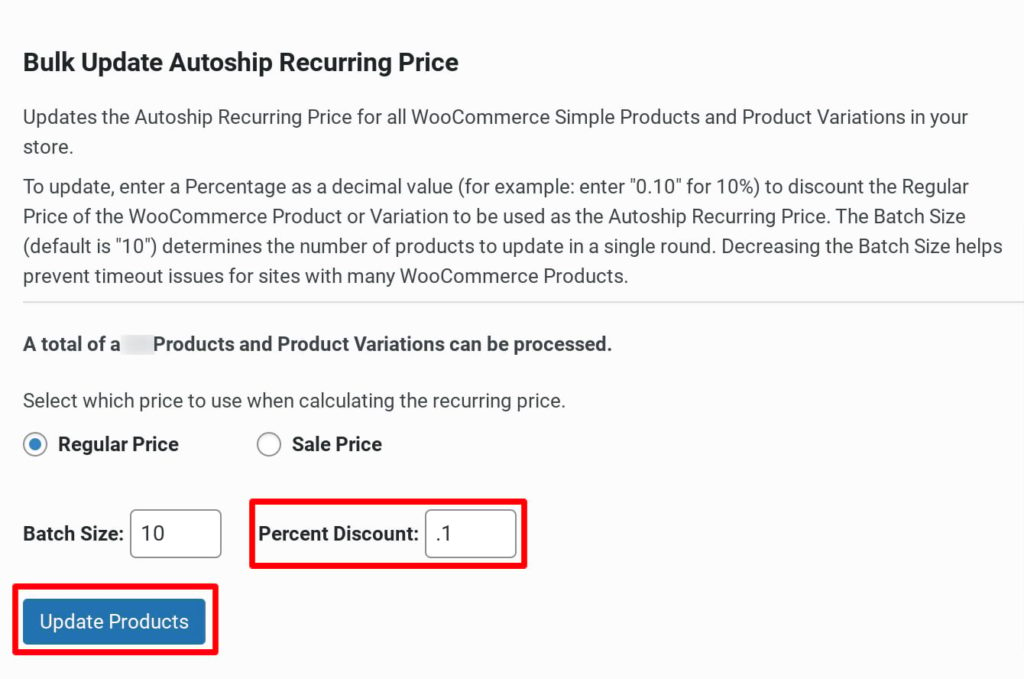
(If you want to offer the subscription upsells on your checkout/cart page as well, use the Bulk Update Autoship Checkout Price settings.)
Step #3: Enable Autoship on all your products so that the subscribe and save option shows up on all your product pages. To do so, use the Bulk Enable WooCommerce Products to Display Autoship Options settings, check the Enable Autoship option and click Update Products:

That’s it!
You just set up a replenishment subscription WooCommerce store within minutes with Autoship Cloud! If you’re looking to set up customizable curation or access subscriptions, let us know and we’ll guide you through the process.
If you only want to enable subscriptions for a select few products, you can do so too. Just choose the product you want to turn into a subscription and use these tutorials:
- How to set up simple product subscriptions on WooCommerce
- How to set up variable product subscriptions on WooCommerce
Autoship Cloud doesn’t just work for B2C or D2C physical goods businesses, but it works seamlessly in the B2B niche too.
You’re now ready to launch your eCommerce subscriptions. But we can’t talk about eCommerce subscriptions without touching upon the churn issue.
Fighting eCommerce subscription churn
eCommerce product subscriptions — just like SaaS subscriptions — see a good deal of churn — about 40% of subscribers cancel their plans. Zooming in on the eCommerce subscription churn timeline shows a few insights:
- About one-third of consumers who subscribe cancel within the first three months.
- Over half cancel their subscription plans within six months.
- And about 40% retain their subscriptions over a period of a year and turn into genuinely loyal customers — lifetime subscribers.
If this data tells you something, it’s this: Focus on retention right from the start as you’re likely to lose many very early on. Different subscription models take different anti-churn efforts.
Fighting churn in the replenishment/subscribe-and-save eCommerce subscription model
If subscribers feel stocked up for some time, they can be quick to cancel their replenishment plans. “Skips” — letting users skip their upcoming shipment(s) — is the answer here. You should also let your users pause their plans, similar to skipping. You can even let your users reschedule their scheduled orders to accommodate their current stock levels. For example, if a user is away for a week, they can choose a later delivery date for their order — an excellent alternative to canceling. They should also be able to reduce the quantity of an item if that works better for them.
Choosing a subscription solution that offers all these features is therefore very important.
Fighting churn in the curation eCommerce subscription model
Curation box subscribers typically end subscriptions when they don’t find value in it. Getting irrelevant items is one common reason. To avoid this, a few subscription services give users a preview of their upcoming “surprise” box. Users further get the option to skip an order if they want to. If you use an algorithm to come up with your curated boxes, keep investing in it. Some curation services even use real, humans for curation — stylists for apparel curation services, for instance — to offer personalized one-on-one customer experiences.
Fighting churn in the access/membership eCommerce subscription model
Depending on the items an access subscription business offers, access subscribers can be quick to cancel. Deals and discounts that seem enticing at first can offer diminishing results over time. In general, if subscribers don’t get good value for their money, they cancel their plans.
Subscription companies need to watch out for passive churn too. Things like failed payment methods can easily cause you to lose subscribers. To avoid these, use a payment gateway that offers smart retries. Additionally, with Autoship Cloud, you can keep your support team in the loop on order failure statutes and field such instances.
But despite your best efforts, cancellations are inevitable. The next best thing that you can do in such cases is to learn why cancellations happen. With Autoship Cloud, you can create a segment of such consumers and use a free survey tool (like Google Forms) to find out how you can lower your churn rate.
Wrapping it up…
Subscriptions are a great way to generate guaranteed recurring revenue and sales in eCommerce. The eCommerce subscription model also gives you more opportunities for cross-selling and upselling, which increases your average order value while ensuring a good customer lifetime value. Subscription models also encourage customer loyalty.
If your store sells products that can be subscribed to, consider offering subscriptions. If you run a WooCommerce store, go with Autoship Cloud for powering your subscriptions.
In just a few clicks, you can create a global subscription program (offer a discount of 10% for subscribing, for example) and convert all your products into subscriptions. Such subscribe and save plans are ideal for replenishment products. You can also use Autoship Cloud to set up bespoke subscription box WordPress websites and access stores. Get in touch with the Autoship Cloud team to discuss your eCommerce subscription needs.
QPilot’s Autoship Cloud adds end-to-end subscription management to WooCommerce. As a result, there is no need to install dozens of plugins, extensions, or services and worry about endless integrations and APIs. Sign up for a QPilot-Autoship Cloud account now to get started. We offer a free two-week trial of our eCommerce subscription platform and plugin, so you don’t have to spend upfront. Your billing cycle only begins when you’re ready!
Grow Subscriptions with Autoship Cloud
Mission Farms migrated to Autoship Cloud powered by QPilot so that they could offer a better experience for their existing Subscribers, reduce the overhead of plugins + code needed to manage subscriptions with their online store, and work with a partner that knows how to support growing their subscription revenue. Since their migration in July of 2022, Mission Farms has improved their Active Subscriber count 52% and grown Subscription Revenue over 62%!
Ready to grow your subscription revenue?
